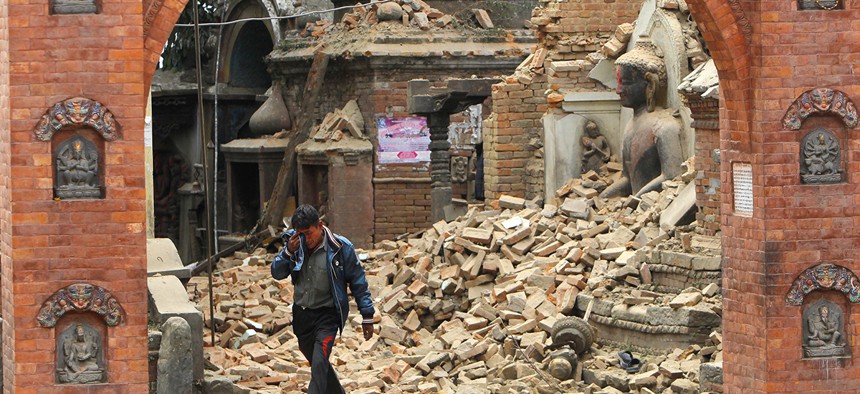This Technology Is Designed to Predict Big Earthquakes and Save Lives. So Why Can't It Get Funding?

A Nepalese man cries as he walks through the earthquake debris in Bhaktapur, near Kathmandu, Nepal. The violence of the 7.8-magnitude earthquake left countless towns and villages across central Nepal in a shambles. Niranjan Shrestha/AP FIle Photo
Last week, in less than four days, the world had three earthquakes at 7.0 magnitude or more.
Last week, in less than four days, the world had three earthquakes at 7.0 magnitude or more. One in Myanmar caused two deaths; in Japan, there were 40; and in Ecuador, there have been 350 killed and still counting.
Two methods have been shown to save lives: building earthquake-proof buildings and installing systems that sound an alarm when an earthquake strikes, giving people further away from the epicenter a few seconds warning.
In an ill-prepared country like Haiti, a magnitude 7.0 earthquake in 2010 killed more than 100,000 people. In Japan, with much better buildings, a magnitude 9.0 quake (which releases about 1,000 times more energy than a 7.0) in 2011 killed some 18,000 people.
Only rich countries can afford earthquake-proofing. As for earthquake prediction, it’s “near impossible,” says Richard Luckett of the British Geological Survey. “We have a build-up of stress on a fault line, and we have no idea what the breaking point would be. When the earthquake occurs is essentially a random event.”
However, things might finally be changing. Over the past 10 years, a promising method has emerged, which uses satellites to measure electromagnetic signals that seem to appear in advance of a quake. The only problem: The discoverers of the method are having trouble getting anyone to take it seriously, because hundreds of previous methods of predicting earthquakes have all failed.
Eyes in the skies
A small but hardy group of researchers have used satellites to look at the ionosphere, an upper layer of the atmosphere full of electrically charged particles. They’ve found measurable changes in it as much as 10 days ahead of earthquakes in Nepal (M7.8, 2015), California (M6.0, 2014), Japan (M9.0, 2011), Haiti (M7.0, 2010), Italy (M6.3, 2009), China (M8.0, 2008), and others.
The changes they’ve measured involve a whole host of electromagnetic signals: the conductivity of the air, levels of ionizing radiation, disturbances in magnetic fields, very low frequency waves, and so on. Scientists don’t yet know exactly what causes these signals, but they have some hints.
The leading hypothesis is that, when pressure builds up at a fault line and deforms the earth’s crust, it releases small but measurable quantities of radon gas that’s been trapped in air pockets. Radon is radioactive, and its release may set off some of the electromagnetic signals in the ionosphere. These can be measured both on the ground and from space, but satellites can cover a much larger area.
Now scientists in the Mullard Space Science Laboratory, at University College London, are planning a space mission, called TwinSat, to test the hypothesis. They are hoping to send two small satellites into a low-earth orbit, designed to look for these signals. If they get it right, says Dhiren Kataria of MSSL, earthquakes could be predicted hours to days before they happen. That could save thousands of lives.
Past space missions, such as the micro-satellite DEMETER, launched by French scientists in 2003, and NASA’s QuakeSat (paywall), have provided some evidence for this method of predicting earthquakes. However, Kataria says that many remain skeptical of the data, because many phenomena can produce large electromagnetic signals—from solar flares to military radars.
TwinSat is meant to overcome that limitation. With two satellites a few hundred kilometers apart, scientists will be able to spot electromagnetic signals with one satellite and then, when the second one shows up, use it to triangulate where the signals are coming from. That would help rule out non-earthquake sources.
“Of course, greater the number of satellites, the higher the precision,” says Kataria. “But we need to start with at least two.”
Overcoming quackery
However, the U.K. Space Agency has twice denied funding to TwinSat. The first time, in 2012, Kataria and his team were working with Russian scientists to get the mission off the ground. Both parties needed their respective space agencies to pony up the money, but neither did.
The second time, in 2014, Kataria’s team applied alone, looking to secure just £2 million ($2.9 million)—a tiny amount for a space mission. It lost out to, among others, a project to help Kazakhstan make better use of satellite data.
Why is something that could potentially save thousands of lives not getting funding? Luckett offers two hypotheses.
“Earthquake prediction has been something of a dirty phrase among seismologists,” he says. “There has been, you can say, quite a bit of quackery in the name of science. There are people who claim they use their dogs to predict earthquakes. And many such hypotheses have received more credence than they should have.” This has put off serious seismologists from dabbling in the field, and it’s no longer “fashionable” to fund such research.
Second, “the U.K. does not have an earthquake threat,” says Luckett. Other countries, such as the U.S. and Japan, have a more vested interest in testing the idea, but they either don’t have the expertise or haven’t invested the money to develop it. (We have reached out to the UKSA for comment and will update this story if needed.)
It’s unfortunate that, because earthquake prediction has a murky past, reasonable hypotheses aren’t being tested. Luckett agrees that funding shouldn’t be blinded by past examples.
“Sadly, I’m afraid none of us can second-guess what a funding body does.” The only way earthquake-prediction science can take off, Luckett says, is if someone successfully predicts an earthquake.
NEXT STORY: Can the Pentagon keep up with rivals in tech?


